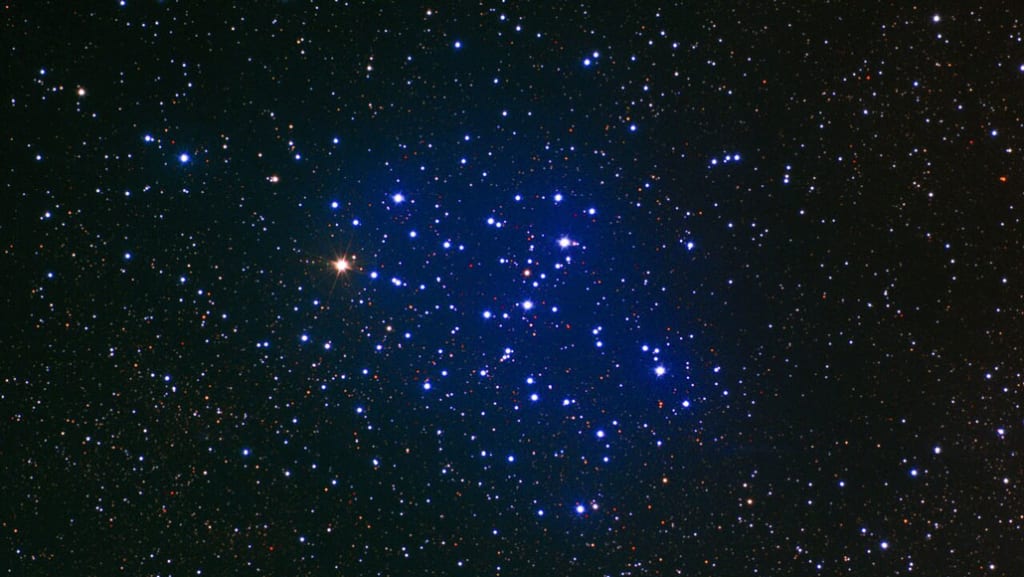WHAT IS THE COLOUR OF STARS
Unveiling the Diverse Palette of Stellar Colors

The color of a star depends on its temperature, with hotter stars appearing bluer and cooler stars appearing redder. This relationship is described by Wien's Law, which states that the wavelength of maximum emission from a blackbody is inversely proportional to its temperature.
Here's a basic breakdown:
Blue Stars: These are the hottest stars, with temperatures exceeding 30,000 degrees Celsius (54,000 degrees Fahrenheit). They emit a higher proportion of blue and ultraviolet light, making them appear blue to our eyes. Examples of blue stars include Rigel in the Orion constellation.
White Stars: Stars with temperatures between 10,000 and 30,000 degrees Celsius (18,000 to 54,000 degrees Fahrenheit) emit a balanced range of colors and appear white. Our Sun is an example of a white star.
Yellow Stars: Stars with temperatures between 5,000 and 10,000 degrees Celsius (9,000 to 18,000 degrees Fahrenheit) appear yellow. Our Sun, despite being classified as a G-type main-sequence star (G dwarf star), is often described as yellow.
Orange and Red Stars: Cooler stars, with temperatures below 5,000 degrees Celsius (9,000 degrees Fahrenheit), emit more red and infrared light. Therefore, they appear orange or red. Betelgeuse, a red supergiant in the Orion constellation, is an example of a red star.
Spectral Classification
Stars are classified based on their spectral characteristics, which include the absorption lines in their spectra. The classification system, known as the Morgan–Keenan (MK) system, categorizes stars into different types (O, B, A, F, G, K, M), each associated with a specific color and temperature range.
O, B, A, F, G, K, M Classification
O-type stars are the hottest and appear blue.
B-type stars are slightly cooler and appear blue-white.
A-type stars are white.
F-type stars are yellow-white.
G-type stars, like our Sun, appear yellow.
K-type stars are orange.
M-type stars are the coolest and appear red.
Hertzsprung-Russell (HR) Diagram
The HR diagram is a graphical representation of stellar properties, plotting luminosity against temperature. Stars follow specific tracks on this diagram based on their evolution. The main sequence, where most stars, including our Sun, reside, shows a clear correlation between temperature and color.
Blackbody Radiation
Stars can be approximated as blackbodies, emitting a continuous spectrum of light. The color is determined by the peak wavelength of this emission. Hotter stars have shorter peak wavelengths in the blue or ultraviolet range, while cooler stars peak in the red or infrared range.
Metallicity
The abundance of elements heavier than helium, known as metallicity, can influence a star's color. Stars with higher metallicity may appear more yellow or white, while those with lower metallicity may lean towards blue.
Variable Stars
Some stars exhibit variability in brightness, and this can impact their perceived color. For example, a variable star becoming brighter may shift from red to orange or yellow.
Binary Systems
In binary star systems, where two stars orbit each other, their interaction can affect their colors. The more massive star might influence the color of its companion through tidal forces or mass transfer.
Astronomical Filters
Astronomers often use filters to observe specific wavelengths of light. This can provide more detailed information about a star's temperature and composition.
In conclusion, the colors of stars are intricately linked to their temperatures, spectral classifications, and the principles of blackbody radiation. The classification system, from O-type (blue and hot) to M-type (red and cool), provides a framework for understanding the diverse range of colors observed in the night sky. Factors such as metallicity, variability, and binary interactions can further influence a star's perceived color.
Stellar color not only serves as a captivating aspect of celestial aesthetics but also offers valuable insights into the physical properties and evolutionary stages of stars. As astronomers continue to explore the universe and refine their observations, our comprehension of the colors of stars contributes to a deeper understanding of the cosmos and the processes governing the life cycles of these celestial entities. The study of stellar colors stands at the intersection of physics, astronomy, and our appreciation of the beauty inherent in the vast tapestry of the night sky.
About the Creator
Enjoyed the story? Support the Creator.
Subscribe for free to receive all their stories in your feed. You could also pledge your support or give them a one-off tip, letting them know you appreciate their work.






Comments (2)
INTERESTING
VERY GOOD BROTHER